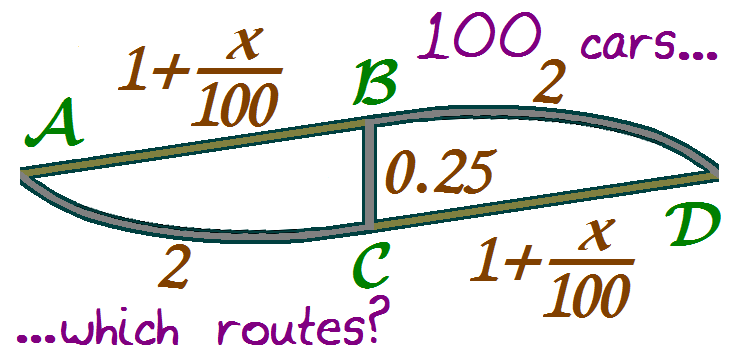
| Several occasions during Hull Unitarian services I have played the music of James Horner, who died in June 2015 in an aeroplane crash. He composed for films so he could be more romantic in style than in contemporary serious music. He wrote the soundtrack for A Beautiful Mind, a slightly fictionalised narrative of John Nash, the mathematical economist who had a severe mental difficulties and was only rewarded the Noble Prize late in his career for what was called the Nash Equilibrium. |
| This brings me to local concern with Hull traffic. You might wonder about the connection. Well, it is often said that Hull's traffic jams started with the box roads (Ferensway, Freetown Way, Great Union Street, Castle Street) and pedestrianising roadspace in town. Possibly, but the Nash Equilibrium tells us that it is sometimes useful to close a road to speed up journey times! |
| The Nash Equilibrium is: when everyone knows everyone else's strategy, each person individually can find no strategic benefit in altering their own behaviour. That's an equilibrium. |

| Suppose 100 cars want to travel from A to D. They can go A B D or A C D or use that extra rat-run road. The numbers in brown represent time and each car is one X. |
| The first cars of the hundred will be attracted by the roads with the formula, as they are faster. Sensitive to traffic levels, drivers go up A to B (quicker than A to C). As the traffic fills up, these roads slow down. At B cars will use the rat run because the formula road C to D will be quicker even with the rat run. Marginally, each extra car slows down on C to D. As that rat run loses its attraction, cars will go direct from B to D. As all of those slow down, cars will go A to C with a fixed travel time. |
| Mathematically the cars are counted as a block of 100, as if all together, because with shared perfect information all cars behave as if they were the last car. |
| The equilibrium is established (at the margin, as a block) where 75 cars go A to B, taking 1.75 units of time, 50 of those veer off down the rat run so that they go B to C taking 0.25 more, and then this makes 75 taking 1.75 units of time traversing C to D. That deviation of B to C to D is as quick as going B to D. 25 cars go A to C realising that their journey time was 2 plus 1.75. So the journey time for every car is always 3.75, and everyone sticks to their individual route and we have equilibrium. |
| However, if you pedestrianise the road B to C, then 50 cars go from A to B and 50 go from A to C, and the journey time on routes A to B and C to D of 50 cars each take 1.50 units of time, and thus the journey time for all cars is 3.50. In other words, less road space quickens the journey. |
| In 1968 Dietrich Braess, working on traffic modelling, noticed that adding a road to a congested road traffic network could increase overall journey times! Thus Nash's equilibrium here involves Braess' paradox. In practical terms drivers switch routes until they reach the Nash Equilibrium. |
| The explanation lies in the mix of traffic sensitive roads and roads with fixed capabilities for journey times in these parameters. These conditions bring along a Nash Equilibrium which is not most efficient until the inner city road is closed. |
| Thus, up to a point, when in Hull you build a Castle Street and a Freetown Way, you shut some roads in between! |
| Aldi opened a new supermarket on June 25th near where I live on Sutton Road, but I have established that from the Unitarian church my journey time is quicker if I go to Aldi on Beverley Road and take longer and less congested routes to it and home. Other switchers will revert back as well. |
June 28 2015
Adrian Worsfold
Pluralist - Liberal and Thoughtful